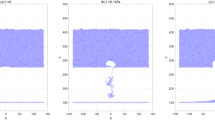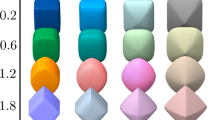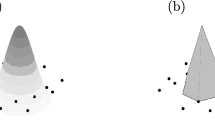Abstract
The paper proposes a hybrid analytical–numerical model for calculating the maximum elastic force acting on a flow-driven prolate spheroidal particle during its collision with a rigid wall. This model assumes that the maximum elastic force is a function of normal impact velocity, particle material properties, particle size, particle aspect ratio and particle orientation angle. The relationship between the parameters is determined by dimensional analysis. The remaining unknown coefficients are calibrated by performing finite element (FE) simulations. The solutions for particle aspect ratios of 1.5, 2 and 3 are presented. The proposed model is verified by comparison with independent FE simulation results for different normal impact velocities, particle material properties, particle sizes, particle aspect ratios and particle orientation angles. The results of the comparison between the results of the proposed model and the FE simulation results show a good agreement for small deformations of the particle. The model is valid for any properties of particle material, particle sizes and particle orientation angles.












Similar content being viewed by others
Data availability
the data that support the findings of this study are available from the corresponding author upon reasonable request.
References
Almohammed N, Breuer M (2016) Modeling and simulation of particle–wall adhesion of aerosol particles in particle–laden turbulent flows. Int J Multiph Flow 85:142–156. https://doi.org/10.1016/j.ijmultiphaseflow.2016.06.013
Ariane M, Sommerfeld M, Alexiadis A (2018) Wall collision and drug-carrier detachment in dry powder inhalers: using DEM to devise a sub-scale model for CFD calculations. Powder Technol 334:65–75. https://doi.org/10.1016/j.powtec.2018.04.051
Cheung CS, Cao YH, Yan ZD (2005) Numerical model for particle deposition and loading in electret filter with rectangular split-type fibers. Comput Mech 35:449–458. https://doi.org/10.1007/s00466-004-0634-5
Cui Y, Hu R, Ravnik J, Yinshui L, Zhou X, Hribersek M, Steinmann P (2021) Analysis of elastic force of fibres during the collision with a wall at arbitrary orientation angles: the importance of fibre’s secondary collision. Submitted to Particuology
Cui Y, Ravnik J, Steinmann P, Hriberšek M (2019) Settling characteristics of nonspherical porous sludge flocs with nonhomogeneous mass distribution. Water Res 158:159–170. https://doi.org/10.1016/j.watres.2019.04.017
Cui Y, Sommerfeld M (2019) The modelling of carrier-wall collision with drug particle detachment for dry powder inhaler applications. Powder Technol 344:741–755. https://doi.org/10.1016/j.powtec.2018.12.067
Fan F-G, Ahmadi G (1995) A sublayer model for wall deposition of ellipsoidal particles in turbulent streams. J Aerosol Sci 26:813–840. https://doi.org/10.1016/0021-8502(95)00021-4
Fang Z, Wang H, Zhang Y, Wei M, Wu X, Sun L (2019) A finite element method (FEM) study on adhesive particle–wall normal collision. J Aerosol Sci 134:80–94. https://doi.org/10.1016/j.jaerosci.2019.04.018
Fang Z, Zhang Y, Wei M, Zhao S, Sun L, Wu X (2020) The critical sticking velocity of non-spherical graphite particles: a numerical study and validation. Nucl Eng Des 359:110453. https://doi.org/10.1016/j.nucengdes.2019.110453
Fang Z, Zhang Y, Wei M, Zhao S, Wu X, Sun L (2020) A numerical study on adhesive collision between a micro-sized particle and a wall. Powder Technol 360:769–779. https://doi.org/10.1016/j.powtec.2019.08.114
Feng Y, Kleinstreuer C (2013) Analysis of non-spherical particle transport in complex internal shear flows. Phys Fluids 25:091904. https://doi.org/10.1063/1.4821812
Hentschel ML, Page NW (2006) Elastic properties of powders during compaction. Part 1: pseudo-isotropic moduli. J Mater Sci 42:1261–1268. https://doi.org/10.1007/s10853-006-1145-x
Hu Y, Yao Z, Hu J (2009) An analytical model to predict residual stress field induced by laser shock peening. J Manuf Sci Eng 131:031017. https://doi.org/10.1115/1.3139219
Johnson KL (1982) One hundred years of Hertz contact. Proc Inst Mech Eng 196:363–378. https://doi.org/10.1243/pime_proc_1982_196_039_02
Kosinski P, Hoffmann AC (2009) Extension of the hard-sphere particle–wall collision model to account for particle deposition. Phys Rev E 79:061302. https://doi.org/10.1103/physreve.79.061302
Landau LD, Pitaevskii LP, Kosevich AM, Lifshitz EM (2012) Theory of elasticity. Elsevier Science, Amsterdam
Logan JD (2013) Applied mathematics, 4th edn. Wiley, New York
Parker G (1978) Self-formed straight rivers with equilibrium banks and mobile bed. Part 1. The sand-silt river. J Fluid Mech 89:109–125. https://doi.org/10.1017/s0022112078002499
Schiller L, Naumann A (1933) Über die grundegenden berchnungen beider schwerkraftaufbereitung. Z. Ver. Deut. Ing. 77:318–320
Surhone LM, Tennoe MT, Hennsonow SF (eds) (2010) Dirichlet boundary condition. Betascript Publishing, Riga
Tian L, Ahmadi G, Wang Z, Hopke PK (2012) Transport and deposition of ellipsoidal fibers in low Reynolds number flows. J Aerosol Sci 45:1–18. https://doi.org/10.1016/j.jaerosci.2011.09.001
Zhang K, Chanpura RA, Mondal S, Wu C-H, Sharma MM, Ayoub JA, Parlar M (2014) Particle size distribution measurement techniques and their relevance or irrelevance to sand control design. In: Day 1 Wed, February 26, 2014. SPE. https://doi.org/10.2118/168152-ms
Zhang Y, Fang Z, Zhao S, Wei M, Wu X, Sun L (2020) An experimental study on the wall collision of micro-sized graphite particles by high-speed photomicrography. Prog Nucl Energy 125:103391. https://doi.org/10.1016/j.pnucene.2020.103391
Zhao J, Dong Y, Ye C (2021) Optimization of residual stresses generated by ultrasonic nanocrystalline surface modification through analytical modeling and data-driven prediction. Int J Mech Sci 197:106307. https://doi.org/10.1016/j.ijmecsci.2021.106307
Acknowledgements
The authors acknowledge the financial support by the Chinese Fundamental Research Funds for the Central Universities of the Project 2020kfyXJJS065; The authors also thank the Deutsche Forschungsgemeinschaft for the financial support in the framework of the Project STE 544/58 and the joint Chinese–Slovenian bilateral research Project BI-CN/20-22-002 funded by the Slovenian Research Agency and the Ministry of Science and Technology of China.
Author information
Authors and Affiliations
Corresponding author
Ethics declarations
Conflict of interest
The authors declare that there is no conflict of interest.
Additional information
Publisher's Note
Springer Nature remains neutral with regard to jurisdictional claims in published maps and institutional affiliations.
Rights and permissions
About this article
Cite this article
Hu, R., Liu, Y., Ravnik, J. et al. A hybrid analytical–numerical model for calculating the maximum elastic force acting on a flow-driven elastic prolate spheroidal particle during its collision with a rigid wall. Comput Mech 69, 1021–1029 (2022). https://doi.org/10.1007/s00466-021-02127-w
Received:
Accepted:
Published:
Issue Date:
DOI: https://doi.org/10.1007/s00466-021-02127-w




